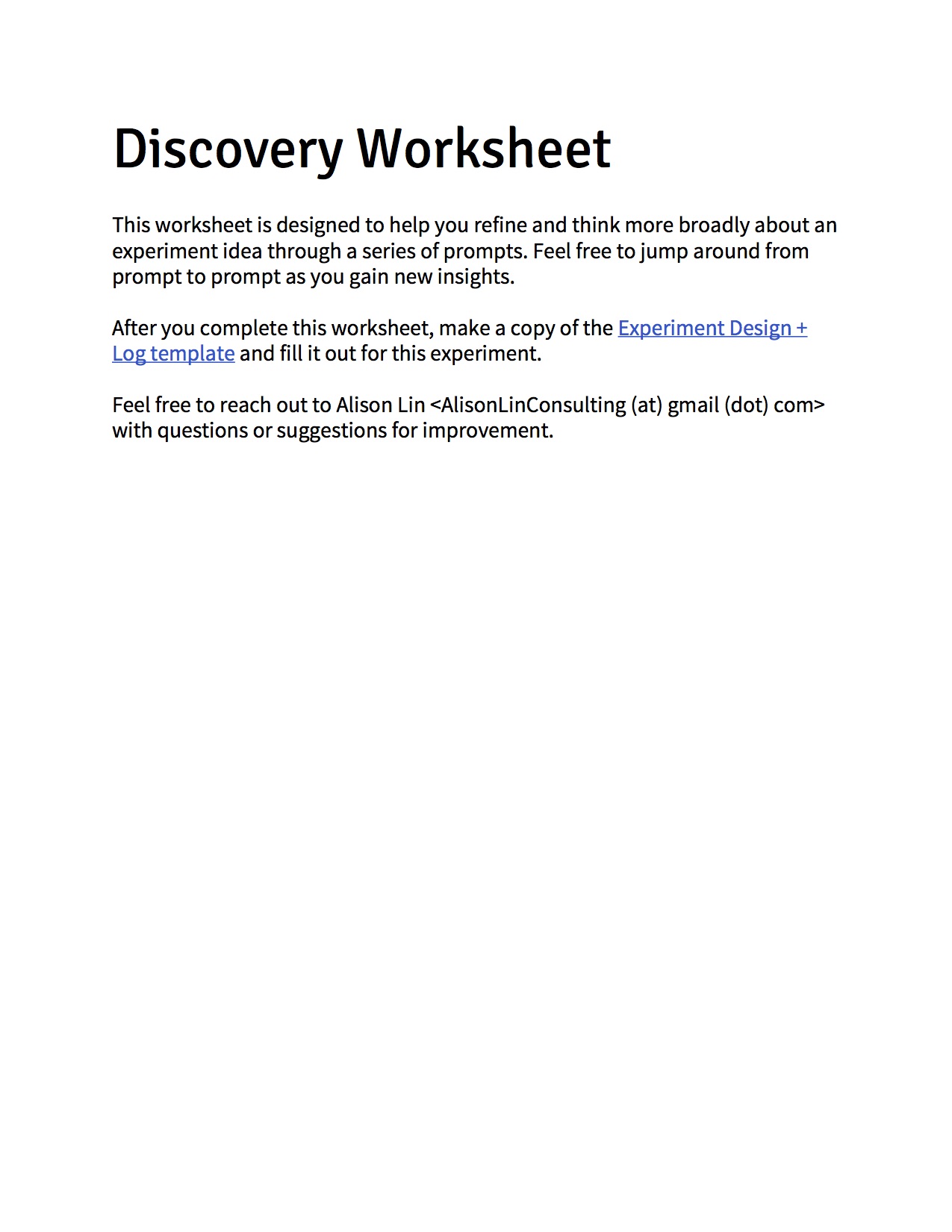 Experimentation is a central practice for groups trying to collaborate more effectively, especially those that are trying to tackle complex problems. In particular, experimentation is a powerful way for a group to learn and improve collectively and quickly.
Experimentation is a central practice for groups trying to collaborate more effectively, especially those that are trying to tackle complex problems. In particular, experimentation is a powerful way for a group to learn and improve collectively and quickly.
However, it’s not easy to do this. It requires discipline and rigor, a set of well-developed muscles and mindsets, and structures that support these practices.
This page describes the process and public domain tools that we use both for our own experiments and to support others in learning through experimentation. They were developed by Eugene Eric Kim and Alison Lin in collaboration with and inspired by many others. (See the Acknowledgements section below for more.)
Collective Learning and Improvement
Why do we need a “process” for experimentation in the first place? Isn’t experimentation simply trying stuff, and seeing what happens?
At its core, yes. But if your goal is to learn and adapt quickly to this complex, ever changing world, then you need to experiment in a more structured, systematic way. Specifically, you need to:
- Craft your experiments with care, paying particular attention to isolating your assumptions and finding the simplest possible things to test
- Make time for planning and meaning-making
- Support individual agency, so that you can test many things in parallel and that decisions aren’t made at the whims of those who happen to hold structural power
We see four stages of development for experimentation:
| Crawl | Walk | Run | Fly |
|---|---|---|---|
| Try stuff, see what happens | Track results, make meaning | Learn, adapt quickly | Do all this collectively |
Process
 Our process consists of four steps:
Our process consists of four steps:
- Discovery. What questions are you trying to answer, and why?
- Design. What’s your hypothesis? How will you measure success? When will the experiment start and end?
- Doing & Documenting.
- Meaning-Making. What did you learn? What do you want to do next?
The steps themselves are simple. Doing them well and with discipline is challenging. The tools below are meant to help with this, but one of the best ways to support this process is to find an external facilitator or coach who can guide you through this process. (Feel free to contact Eugene for referrals.)
Tools
Both the Discovery and Design + Log templates are Google Docs. To use, click on the template, go to the File menu, and select, Make a copy. This will make a copy of the template and add it to your My Drive. Rename the file, and start using!
Discovery Template
 |
Google Docs template
This worksheet helps you identify the problem you’re trying to solve. You can use it both to brainstorm ideas to test or to refine and explore ideas you already have. You don’t have to use this every time you come up with an experiment or even at all. However, we think it’s a good practice to go through a discovery process on a regular basis to make sure you’re answering the right questions and to encourage more creative thinking. |
Design + Log Template
 |
Google Docs template
This worksheet helps you design and track your experiment. It asks you to articulate your hypothesis, the start and end dates, and how you’ll measure success, and it gives you a space where you can track results. |
Dashboard
We use LearnQuickly.us, a tool designed by Duende, to aggregate, track, and visualize all of the experiments that are happening in real-time.


For a live example, see Faster Than 20’s LearnQuickly.us dashboard.
Muscles & Mindsets
Effective experimentation requires these well-developed muscles and mindsets:
| Experimentation Muscles | Experimentation Mindsets |
|---|---|
|
Bias toward action. “The sooner I start trying, the faster I’ll learn.”
Improvement is a practice. “The more I try, the better I’ll get.” Fail fast forward. “Mistakes are part of learning.” Slow down to speed up. “I’ll work smarter if I slow down.” Diversity and data. “I have blind spots. I need to compensate for them to get the best results.” |
Simply doing the work will help you develop these muscles and mindsets, but you can also develop them more intentionally through a workout program.
Resources
Eugene Eric Kim, Alison Lin, Jodie Tonita, and Eden Kidane shared their experiences using and supporting this experiment process at Social Transformation Project on a May 26, 2016 webinar, “Getting Real About Experimentation,” hosted by Leadership Learning Community. Download Slides
Relevant blog posts:
- “Getting real about experiments and learning.” By Eugene Eric Kim. March 18, 2014.
- “Documenting is not learning.” By Eugene Eric Kim. March 27, 2014.
- “The key to effective learning? Soap bubbles!” By Eugene Eric Kim. April 1, 2014.
- “Actually, documenting is learning!” By Eugene Eric Kim. April 3, 2014.
- “Boldly going where no one has gone before.” By Rebecca Petzel. April 23, 2015.
Acknowledgements
We were conceptually inspired by Lean Startup and Clark Kellogg’s Problem Finding, Problem Solving approach to innovation, as well as our own experiences and lots of trial and error.
The basis of our tools, templates, and process came from work Eugene and Alison did in 2015 with Rebecca Petzel and Duende’s Amy Wu on Future Forward. They further developed their tools and processes through their work with Social Transformation Project in 2016.
The Crawl / Walk / Run / Fly framework is adapted from Beth Kanter.